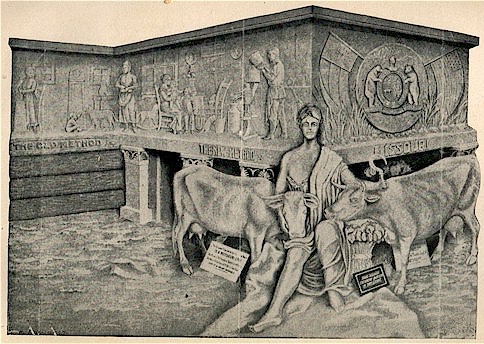
|
Agricultural History Series |
Missouri State University |
1904 St. Louis Worlds Fair
Missouri Butter Sculpture
The Missouri butter exhibit was regarded as one of the prominent attractions and many people expressed that their entire trip was compensated for with this exhibit alone. The Missouri Commission spent ten thousand dollars on this exhibit alone so the magnitude of this impressive project equaled the workmanship of the sculptor.
The central figure in the exhibit was “Ceres”, the Goddess of Agriculture holding a sickle in her hands, then on either side of her was a model of a dairy cow. The one on the right represented the Jersey breed and was modeled off of a famous cow owned by a Dr. Still of Kirksville Missouri. This cows head and neck was shown resting on a sheaf of wheat with her nose in the lap of “Ceres”. The cow on the left was a representation of a champion Holstein owned by M.E. Moore of Cameron Missouri. This cow was in a test at the worlds fair and produced 270 lbs of butter in ninety days. Both owners pronounced the likenesses a perfect rendition of their animals.

Missouri Butter Exhibit
On the walls surrounding the central exhibit a story was portrayed in solid butter starting at the left was a figure of a woman churning with an old fashioned churn. Then in the next corner was a woman skimming a pan of milk on which the cream had raised by the old gravity process. Between the two on the floor of a scantily furnished log home was a boy feeding his dog. This represented the old methods. To the right of this at right angles was a mother playing with her children while a boy separated the milk with a centrifugal separator. This represented the new method. Around the corner from this was a reproduction of the seal of the state of Missouri. All of this was done in solid butter.
The entire exhibit was made of pure solid butter, 3,000 pounds worth of butter to be exact. To make 3,000 pounds of butter required 75,000 pounds of milk or 9,000 gallons this is equal to an average milking from 6,000 cows. The space occupied by the exhibit was eight feet by twenty-eight feet, making 224 square feet of floor space, and about 325 square feet of wall space. All of this was inside a refrigerated case with a glass front of three thicknesses of plate glass with airspace between each
Reference: Missouri Agricultural Report, 1905.
This page is designed by Mike Reade and is maintained by Lyndon Irwin.